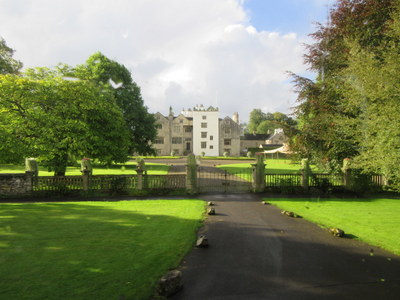
 Our first stop of the day was just 15 minutes down the road from the hotel—Levens Hall, a stately home, still privately owned and occupied, that boasts not only elaborate interiors but the world's oldest topiary garden.
Our first stop of the day was just 15 minutes down the road from the hotel—Levens Hall, a stately home, still privately owned and occupied, that boasts not only elaborate interiors but the world's oldest topiary garden.Thursday, 11 September 2025, Levens Hall, Chester, Wales (The Quay Hotel)
Written 19 October 2025
The first order of business on the bus this morning was a minute of silence in honor of the date.

 Our first stop of the day was just 15 minutes down the road from the hotel—Levens Hall, a stately home, still privately owned and occupied, that boasts not only elaborate interiors but the world's oldest topiary garden.
Our first stop of the day was just 15 minutes down the road from the hotel—Levens Hall, a stately home, still privately owned and occupied, that boasts not only elaborate interiors but the world's oldest topiary garden.
Someone asked about a large handsome tree we saw across an expanse of lawn and was told it's a "variegated tulip tree," though from that distance, it didn't look any more variegated than any other Liriodendron, like the ones we have around Tallahassee. It's the one to the left of the gates in the left-hand photo, partially obscured by some other tree in front of it. (The V-shaped white mark is an out-of-focus water droplet on the bus window.)
Just inside a smaller gate near the front door, we were greeted by this amazing mozaic, perhaps 4 or 5 feet across, made of flat river pebbles set on edge. The guide didn't say anything about it, and I didn't get a chance to ask, so I have no idea who made it, when, or why a goat.
No photos were allowed inside the house, so I'm limited here to what the docent told us.
The de Redman family was granted the land by the 13th century by the Norman Baron of Lancaster. They built the house and a pele tower in 1285. The pele tower had a signal fire on top, so that the occupants could warn the neighbors of the approach of Scottish border reivers, who actually came this far into England.
In the late 1500's, the Bellinghams acquired it and cut down enough ancient oaks on the estate to panel the house. They enlarged the manor house. The docent pointed a curved hunting horn mounted on the way that marks the doorway into the Elizabethan part of the house.
The last Bellingham lost it all, gambling. Colonel James Grahame bought it in 1688 and signifcantly remodeled it. He's the one who hired Guillaume Beaumont (the gardener who designed the gardens at Hampton Court) and started the topiary gardens in 1694. Today, they're the oldest topiary gardens in the world.
In 1880 the Bagots inherited, and still own it. Richard baggot and his young family live here, in a more recent wing with a clock tower and a square crenelated tower. (The Duke of Wellington apparently had a niece who was a Bagot.)
The docent pointed out many interesting features as we went through the rooms

 Back outside, we got a tour of the gardens. It was raining lightly, but nobody much cared. The gardens were spectacular. The absolute forest of topiary (over 100) was only the beginning, maybe a quarter of the 10-acre plantings. The bowling green is now used as a croquet lawn, but the orchard and vegetable garden are still working.
Back outside, we got a tour of the gardens. It was raining lightly, but nobody much cared. The gardens were spectacular. The absolute forest of topiary (over 100) was only the beginning, maybe a quarter of the 10-acre plantings. The bowling green is now used as a croquet lawn, but the orchard and vegetable garden are still working.
I was surprised to learn that the topiary figures are not figurative or representational; there are no birds or dinosaurs, just abstract and geometric shapes. The original gardeners preferred to let the plants determine the shapes they would take and simply to enhance and emphasize those shapes.
The annual trimming was in progress, and as you can see, the cherry picker hadn't yet brought the gardeners to the lower near side of the one at the right.
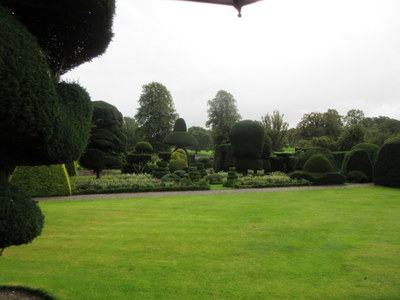
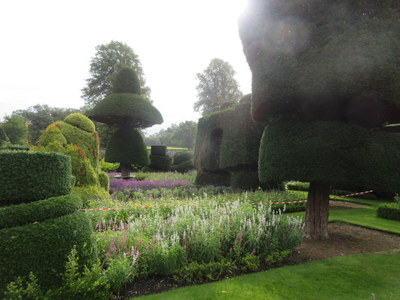 Many of the individual plants have been there from the beginning, planted in 1694 when the gardens were established.
Many of the individual plants have been there from the beginning, planted in 1694 when the gardens were established.
Most of the space under them was planted with ornamental flowers: anise hyssop, heliotrope, mealy cup sage, slender vervain, ageratum, English lavender. The theme for the season seemed to be bluey-purple.
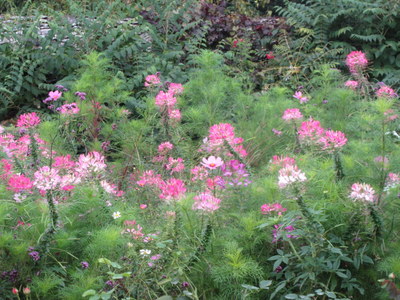
 I especially liked this luxuriant bed of Cleome with a few Cosmos mixed in. I needed the help of the Picture This app to identify a lot of the flowers, and many more species and varieties were present that I didn't get photos of and therefore couldn't identify after the fact.
I especially liked this luxuriant bed of Cleome with a few Cosmos mixed in. I needed the help of the Picture This app to identify a lot of the flowers, and many more species and varieties were present that I didn't get photos of and therefore couldn't identify after the fact.

 Rambling over several of the shrubs was this hansome vine with bright red tubular flowers and palmately compound leaves—a complete mystery to me. I tried several times, focusing on several different parts of the plant, and Picture This gave me six different identifications, none even remotely plausible—I mean, Oxalis? ocotillo? elephant's foot? Adenium? hellebore? Virginia creeper?! Seriously?!
Rambling over several of the shrubs was this hansome vine with bright red tubular flowers and palmately compound leaves—a complete mystery to me. I tried several times, focusing on several different parts of the plant, and Picture This gave me six different identifications, none even remotely plausible—I mean, Oxalis? ocotillo? elephant's foot? Adenium? hellebore? Virginia creeper?! Seriously?!

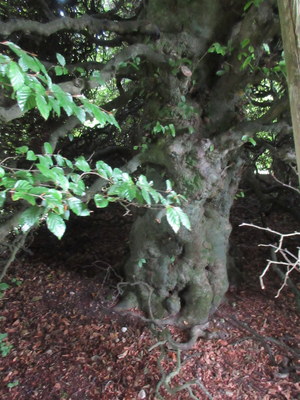 Passing through the orchards, I got this shot of medlars (left). The medlar is in the rose family, with the apples and pears, but is more closely related to the hawthorns. It's fruit looks like an apple with cleft palate—as though the blossom end had never closed properly. They are famous for being "rotten before they are ripe," and it's often said that you have to let them rot before they're edible. In fact, they go through a process called "bletting," during which the flesh darkens and softens, ending up looking and tasting like apple butter. It has caused me untold confusion, because in French, because both "medlar" and "loquat" are rendered into French as "nèfle." The two are both in the rose family but otherwise very different. In literature, medlars are sometimes used as a metaphor for prostitution.
Passing through the orchards, I got this shot of medlars (left). The medlar is in the rose family, with the apples and pears, but is more closely related to the hawthorns. It's fruit looks like an apple with cleft palate—as though the blossom end had never closed properly. They are famous for being "rotten before they are ripe," and it's often said that you have to let them rot before they're edible. In fact, they go through a process called "bletting," during which the flesh darkens and softens, ending up looking and tasting like apple butter. It has caused me untold confusion, because in French, because both "medlar" and "loquat" are rendered into French as "nèfle." The two are both in the rose family but otherwise very different. In literature, medlars are sometimes used as a metaphor for prostitution.
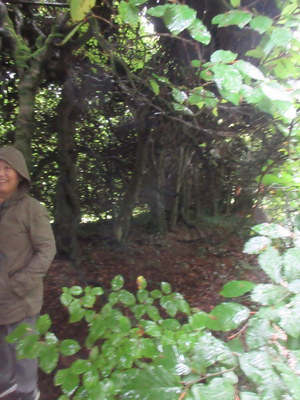
 At the left here is a member of our group standing inside a beech hedge.
At the left here is a member of our group standing inside a beech hedge.
They used to have fine boxwood hedges as well, but they lost them a while back to box blight and replaced them with Japanese holly. Apparently the blight problem has been solved, though, because they're now in the process of changing them back to boxwood.
A linden arbor leads to this circular lily pond with a fountain in the center. The pond does a good job of looking ancient, but it actually only dates from 1994.
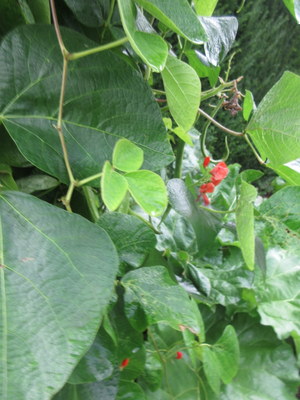
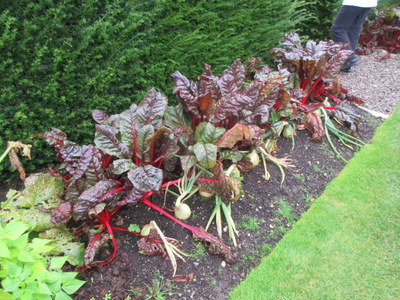 In the vegetable gardens, I spotted these scarlet runner beans, still producing in September.
In the vegetable gardens, I spotted these scarlet runner beans, still producing in September.
Nearby was this bed of Swiss chard (or maybe beets), with a row of onions in front.
Other veggies we saw were rhubarb, celery, squash, bush beans, white Swiss chard, parsley, lettuce, scallions, and chives.

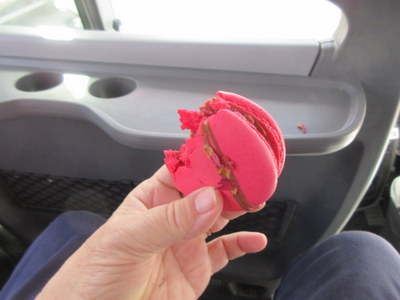 Here, bookended by two towers of runner beans, is a very small patch of very small pumpkins.
Here, bookended by two towers of runner beans, is a very small patch of very small pumpkins.
All of this is maintained by five part-time gardeners, plus volunteers. In the spring, the docent said, the space under the fruit trees is carpeted with bright red tulips. I saw a blackbird (what the French call a merle, closely related to the American robin) in the gardens.
At the far end, the gardens segue directly into pastureland grazed by cattle and sheep. If you venture close enough, you can see that a haha, a narrow but deep "dry moat," keeps the livestock from invading the garden, without marring the vista with an above-ground fence.
Then we were led past a range of modern greenhouses (screened by shrubbery and not open for tours) to our bus. Stefano, always worried we would waste away from malnutrition, handed out large bright red macarons to tide us over until lunch.
Back in the bus, we continued to the historic town of Chester (not to be confused with Chesters, where we saw the Roman artifacts), the only one in Britain that retains its entire defensive wall.
On the way, we passed at least one gib field of maize, and several areas of road cut covered with wide bands of tall white tubes, each sheltering a newly planted tree sapling. When those grow up, the road will be lined with attractive groves of trees.
Stefano continued to regale us with information:
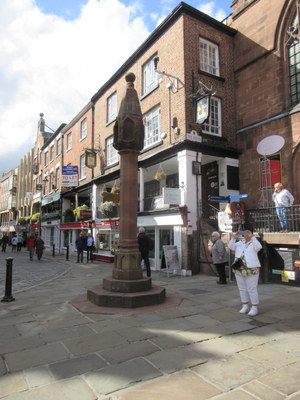
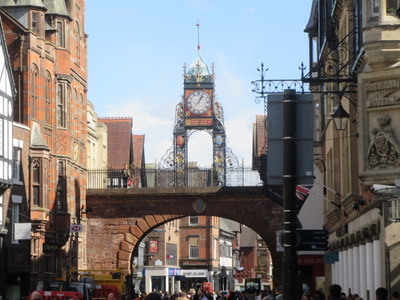 Mick dropped us off at the edge of the old section of Chester, and Stefano led us from there into the center of town, marked by the ancient market cross in the left-hand photo, and turned us loose for two hours at lunch time.
Mick dropped us off at the edge of the old section of Chester, and Stefano led us from there into the center of town, marked by the ancient market cross in the left-hand photo, and turned us loose for two hours at lunch time.
Quite nearby was the magnificent street close in the right-hand photo.
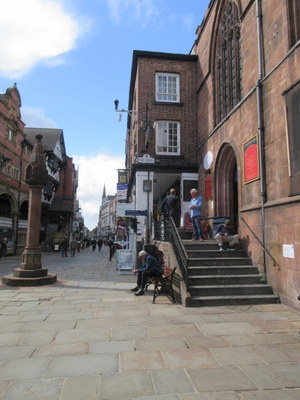
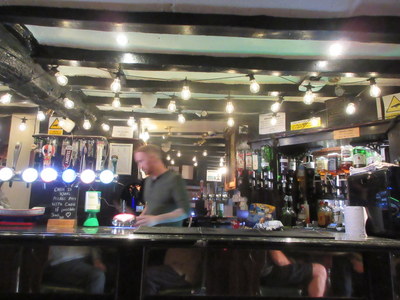 We couldn't believe how many of the group followed Stefano to chain sandwich shop Prêt-à-Manger! We peeled off and climbed these stairs, right next to the market cross, and went into the Victoria, an old-fashioned pub. In the right-hand photo, you can see its low ceiling, authentic beams, numerous beer taps, and barman blurred by motion.
We couldn't believe how many of the group followed Stefano to chain sandwich shop Prêt-à-Manger! We peeled off and climbed these stairs, right next to the market cross, and went into the Victoria, an old-fashioned pub. In the right-hand photo, you can see its low ceiling, authentic beams, numerous beer taps, and barman blurred by motion.

 There we found, at long last, real fish and chips made with actual cod rather than haddock and real bangers and mash, with those starchy sausages David is so fond of, doused with rich onion gravy.
There we found, at long last, real fish and chips made with actual cod rather than haddock and real bangers and mash, with those starchy sausages David is so fond of, doused with rich onion gravy.
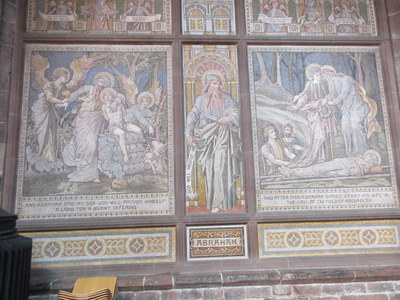
 After lunch, we had an hour before the hike back to the bus. It was windy and raining, and David's foot was hurting, so he needed to sit down for a while more. Accordingly, we went a few blocks to the justly famous Chester cathedral, where David could sit comfortably in a chair and admire these magnificent mosaics telling the stories of Abraham and David.
After lunch, we had an hour before the hike back to the bus. It was windy and raining, and David's foot was hurting, so he needed to sit down for a while more. Accordingly, we went a few blocks to the justly famous Chester cathedral, where David could sit comfortably in a chair and admire these magnificent mosaics telling the stories of Abraham and David.
Meanwhile, I strolled around the nave. I had already alerted Stefano that we planned to save steps by making our own way at our own pace back to the bus pick-up location rather than going out of our way to meet him at the rendez-vous point for the forced march back to it.
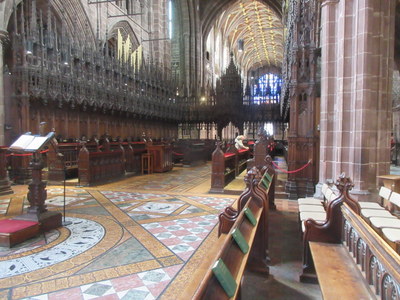
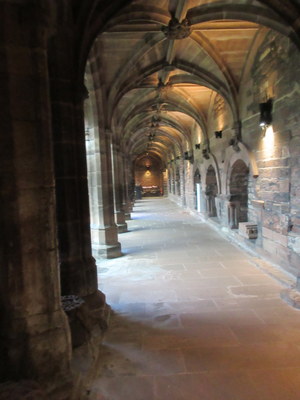 The building itself was beautiful. Here, at the left, is a shot of the nave, looking "backward" from the altar through the choir to the main nave at the rear. At the right, one leg of the cloister.
The building itself was beautiful. Here, at the left, is a shot of the nave, looking "backward" from the altar through the choir to the main nave at the rear. At the right, one leg of the cloister.
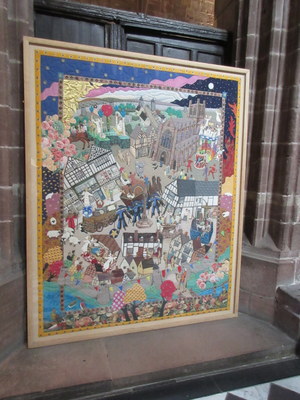
 But the furnishings were wonderful as well. On one of the altars hung this extremely detailed quilt, portraying the cathedral (upper right quadrant) and its neighborhood, during the passage of a circus parade.
But the furnishings were wonderful as well. On one of the altars hung this extremely detailed quilt, portraying the cathedral (upper right quadrant) and its neighborhood, during the passage of a circus parade.
At the right is a close-up of just one small section of it, right in front of the cathedral door. Note the guy with two sheep dogs on leashes, the sidewalk artist kneeling to work on a chalk painting, the float representing Noah's ark (complete with a couple of giraffes, two ducks, and a rainbow). Two elephants and two bears, or perhaps people dressed up as elephants and bears, judging from the elephant's boots and white socks. Just below the horses, you can see the head, hat, shoulders, and arms of one of the blue-clad stilt walkers accompanying the ark.
Elsewhere in the full view of the quilt are a nativity scene flanked by angels and topped with a star; three guys on camels approach from a side street. Other scenes from Jesus' life and death are scattered here and there. Amazing.
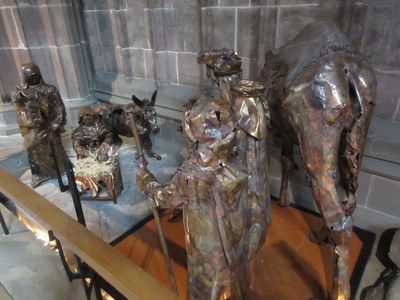
 In one of the side aisles was this circa half-size nativity, made of bronze, I think.
In one of the side aisles was this circa half-size nativity, made of bronze, I think.
And elsewhere still, a great model of the cathedral, with illuminated windows, made of (yes, sorry) Legos. Little Lego people tend tiny Lego flower beds in the cloister.
Our plan worked out well. We got to the pick-up point (the portico of the Crowne Plaza Hotel) just a couple of minutes before Mick pulled up in the bus, and we were warm, dry, and seated inside by the time the others arrived.
On the way out of town, I got a hasty shot, from behind, of an equestrian statue. On the back of the plinth, I could read his dates, and on one side, a list of place names, mostly Spanish, but then a few French, ending with Toulouse. As I Googled the dates, I showed David the image, "These are battles he was in, right?" David took a look and said, "That looks like Wellington's peninsular campaign; they fought over Portugal and Spain then up over the Pyrenees into France (you know, Sean Bean in Sharp's Rifles). One of Wellington's officers must have been from Chester." The Google results were led by one Stapleton Cotton, 1st Viscount Combermere, who was indeed one of Wellington's officers. His Wikipedia page features a photo of the very statue I was trying to identify. I love Google! And, of course, my historically erudite husband.

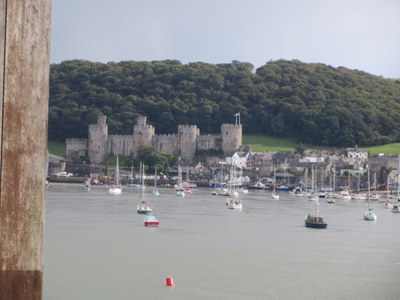 One more hour in the bus got us out of England, into Wales, and to our hotel for the next two nights, the Quay (pronounced "key") in Conwy.
One more hour in the bus got us out of England, into Wales, and to our hotel for the next two nights, the Quay (pronounced "key") in Conwy.
At the left here is my room, which has a view across the Conwy River to the town of Conwy. The silver ice bucket on the dresser was already filled with ice! Behind each of the indoor chairs is hidden an outdoor chair on the balcony.
At the right, slightly telephotoed, is Conwy Castle, also on the far bank.

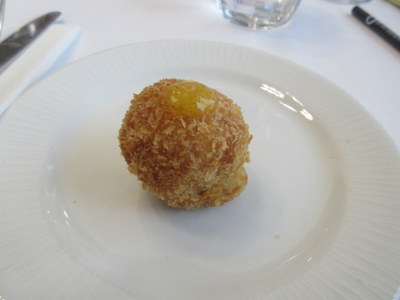 Once we'd settled in, we gathered for a wine tasting and group dinner at the hotel. Again, I probably have the printed menu somewhere in my yet-to-be organized folders of mementos, but I can't say I remember much about the food, and pretty much nothing about the wines.
Once we'd settled in, we gathered for a wine tasting and group dinner at the hotel. Again, I probably have the printed menu somewhere in my yet-to-be organized folders of mementos, but I can't say I remember much about the food, and pretty much nothing about the wines.
At the left is the amuse-bouche, marinated vegetables and olives and a cube of something brown with a little tomato sauce on top.
At the right, the first course, a fritter of some sort. Cheese, I think.

 My main course was fish, European sea bass, I think.
My main course was fish, European sea bass, I think.
David's was a braised meat, pork I think.
There must have been a dessert, but I don't seem to have gotten a photo of it. Not a memorable meal, I guess.
We get a late start tomorrow for our drive to Caernarfon Castle.
Previous entry List of Entries Next entry